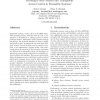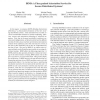949 search results - page 61 / 190 » Design methods for security and trust |
ECOOPW
1999
Springer
14 years 1 months ago
1999
Springer
Extensible systems, such as Java or the SPIN extensible operating system, allow for units of code, or extensions, to be added to a running system in almost arbitrary fashion. Exte...
OSDI
2008
ACM
14 years 9 months ago
2008
ACM
Computers are notoriously insecure, in part because application security policies do not map well onto traditional protection mechanisms such as Unix user accounts or hardware pag...
TCC
2007
Springer
14 years 3 months ago
2007
Springer
Abstract. Cryptographic protocols are often designed and analyzed under some trusted set-up assumptions, namely in settings where the participants have access to global information...
SP
2005
IEEE
14 years 2 months ago
2005
IEEE
In this paper, we propose BIND (Binding Instructions aNd Data),1 a fine-grained attestation service for securing distributed systems. Code attestation has recently received consi...
HICSS
2008
IEEE
14 years 3 months ago
2008
IEEE
Architecting security solutions for today’s diverse computer systems is a challenge. The modern business environment is comprised of many different applications, e-mail, databas...


